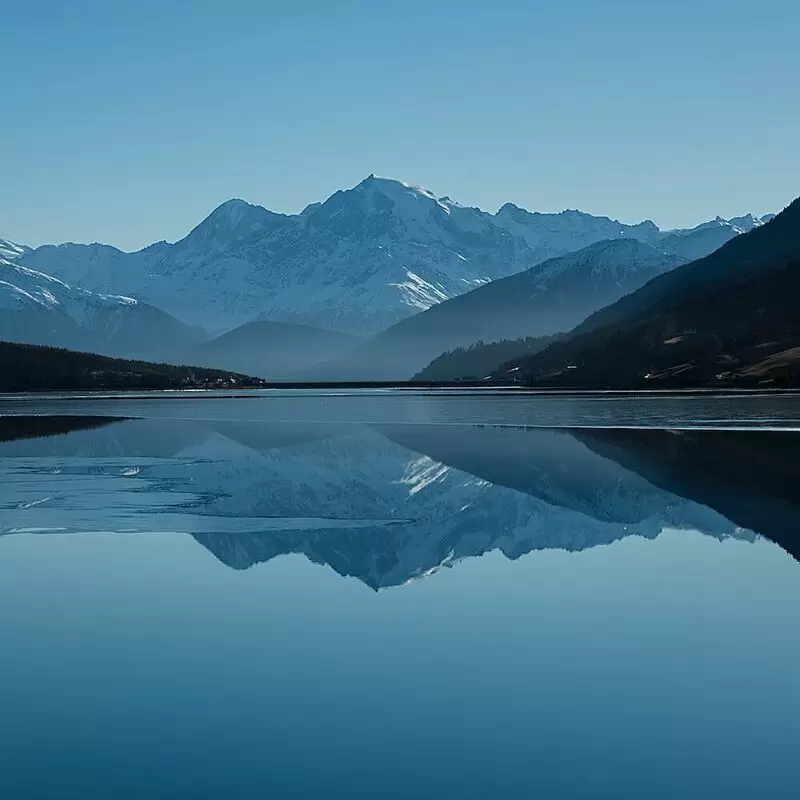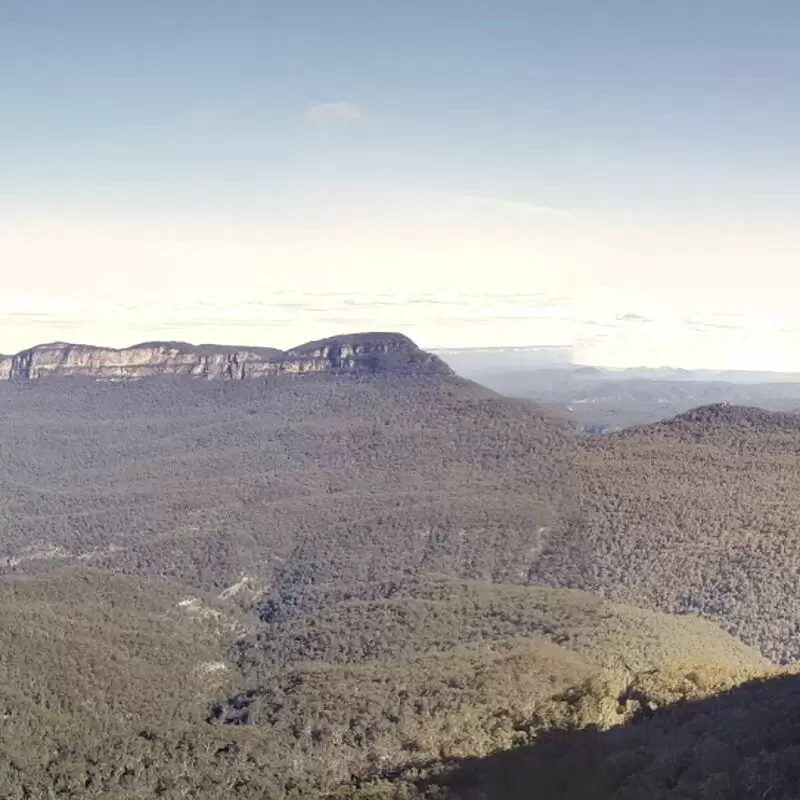
1. Blue Mountains
Discover the natural, scenic beauty of the Blue Mountains in Australia's New South Wales region. Escape the hustle and bustle of city life and immerse yourself in the tranquility this lush mountain range offers. Visit the iconic Three Sisters rock formation and take in the views from the Scenic Skyway - a cable car ride that gives you a bird's eye view of this World Heritage-listed site. Go bushwalking, rock climbing or take a scenic drive to breathtaking sites like Wentworth Falls. Don't forget to sample hearty local dishes and visit the nearby Jenolan Caves - an incredible underground network of limestone caverns just waiting to be explored.
 Blue Mountains
Blue Mountains
Blue Mountains, Blue Mountain

Blue Mountains, Blue Mountain
Best Time to Visit Blue Mountain
The best time to visit Blue Mountain is during the off-season between March and May in the fall and September to November in the spring. During these months, the climate is mild, the crowds are fewer, and the foliage is beautiful. The summer months (December through February) can be hot and crowded, while winter (June through August) can be cold and wet. Nevertheless, Blue Mountain is a year-round destination that has something to offer in every season.
Annual Weather in Blue Mountain
January
Jan
76 / 86 °F
25 / 30 °C
4
10
45
February
Feb
77 / 86 °F
25 / 30 °C
3
9
39
March
Mar
76 / 85 °F
24 / 29 °C
4
8
45
April
Apr
72 / 80 °F
22 / 27 °C
2
5
48
May
May
67 / 78 °F
20 / 26 °C
1
3
62
June
Jun
63 / 74 °F
17 / 23 °C
0
2
69
July
Jul
62 / 73 °F
16 / 23 °C
1
2
79
August
Aug
62 / 75 °F
17 / 24 °C
0
1
91
September
Sep
66 / 78 °F
19 / 25 °C
0
1
80
October
Oct
70 / 81 °F
21 / 27 °C
1
3
79
November
Nov
73 / 85 °F
23 / 29 °C
1
5
71
December
Dec
75 / 84 °F
24 / 29 °C
2
7
66
Questions & Answers
How high is the Blue Mountains?
The Blue Mountains are a breathtaking mountain range in Australia that covers an area of about 11,400 square kilometers. The highest point of the Blue Mountains is Mount Werong, with an altitude of 1,215 meters above sea level. The mountains are known for their incredible scenic beauty, including deep gorges, steep cliffs and lush forests, not to mention the famous Three Sisters rock formation. The Blue Mountains are popular with nature lovers, hikers and adventurers from all over the world.
What's the main attraction in Blue Mountain?
The main attraction of Blue Mountain is its breathtaking natural landscape. The region offers breathtaking views, including vast eucalyptus forests, waterfalls, sandstone cliffs and bright wildflowers. Visitors can explore the area by scenic railroad or cable car, hike through the mountains, or simply relax and enjoy the tranquil atmosphere. Wildlife lovers will enjoy the opportunity to see native species such as wallabies, kangaroos, and colorful parrots. Overall, Blue Mountain is a fantastic destination for those who want to spend a quiet and picturesque vacation.
How far is the Blue Mountain from Sydney?
The Blue Mountains are about 50 kilometers west of Sydney and can be reached in about an hour and a half by car. Alternatively, you can take a scenic train ride from Sydney's main train station to Katoomba, a town in the Blue Mountains, which takes about two hours. The Blue Mountains are a popular weekend destination for many Sydney residents looking for a quick escape from the city. The mountain range offers stunning scenery with scenic hiking trails, breathtaking waterfalls, and beautiful valleys, making it a must-see for locals and tourists alike.
Are there any wildlife animals in Blue Mountain?
Yes, Blue Mountain is home to diverse wildlife, including kangaroos, koalas, wallabies, wombats, opossums and echidnas. Visitors can see these animals in the wild while hiking, biking or walking in the national parks and reserves. There are also wildlife sanctuaries such as Featherdale Wildlife Park where visitors can get up close and personal with these animals. Please note that while encountering wildlife can be an exciting experience, it is important to always keep a safe distance and respect their natural habitat.
What's the history behind the Blue Mountain name?
The Blue Mountains in Australia get their name from the blue hue you can see from afar, caused by the eucalyptus oil that oozes from the vast eucalypt forests. The region has a rich aboriginal history and was home to the Darug and Gundungurra people for thousands of years. The first Europeans to explore the area were British explorers Gregory Blaxland, William Lawson and William Charles Wentworth in 1813.
Is there any hiking trail in the Blue Mountain region?
Yes, Blue Mountains National Park offers several hiking trails for visitors of all levels and interests. One of the most popular trails is Federal Pass, an 11-kilometer trail that takes you through lush vegetation, to breathtaking waterfalls and sweeping views. Another great option is the Grand Canyon Trail, which takes you on a scenic loop through sandstone bluffs, forests and streams. If you're looking for a challenging adventure, try the Six Foot Track, a 45-kilometer hike that takes you from Katoomba to Jenolan Caves. Whichever track you choose, be sure to take plenty of water, snacks and sunscreen.
How long does it take to explore Blue Mountain?
The Blue Mountains are a vast area with a variety of attractions. Visitors can enjoy numerous hiking trails, take in the breathtaking views, visit museums and art galleries, and take nature tours. How long it takes to explore the Blue Mountains depends on your interests and time frame. For a quick visit, one day may be enough to see the highlights, but most visitors prefer a more leisurely pace that spans several days. Some time may be needed for the remote trails, and arranging transportation to some of the more remote sites must be planned in advance.
Are there any waterfalls in Blue Mountain?
Yes, there are some beautiful waterfalls in the Blue Mountains that are a must-see for nature lovers. One of the most famous waterfalls in the area is Wentworth Falls, which offers a breathtaking view of the valley and the gushing stream of water. Another popular waterfall is Katoomba Falls, a series of cascades that can be reached via a scenic bushwalk. Overall, there are several waterfalls in the Blue Mountains that are worth exploring and offer an enchanting experience of nature's beauty.
Is it possible to see the Three Sisters from a different angle?
Yes, it is possible to see the Three Sisters from a different angle. While most visitors view the iconic rock formation from the vantage point of Echo Point or take the scenic railroad down into the valley, there are other ways to enjoy this natural wonder. For a unique perspective, hike the National Pass or the Prince Henry Cliff Walk. Alternatively, visitors can take a helicopter ride or a hot air balloon ride to view the Three Sisters and the surrounding Blue Mountains landscape from the air.
When is the best time to visit the Blue Mountains?
The Blue Mountains are an ideal vacation destination all year round. The stunning scenery and range of outdoor activities offer something for everyone. The summer months are perfect for those who enjoy outdoor adventures such as hiking and climbing, while the cooler months are ideal for those who prefer more cultural experiences such as visiting art galleries and museums and enjoying the local cuisine. Regardless of the season, be sure to pack warm clothes, as the mountains are known for their cooler temperatures, especially in the evening.
Feedback
I hope you found this article informative and helpful. I'm eager to improve the content and make it even more valuable for you. If you have any feedback or suggestions, I would love to hear from you.
Do you have any tips or hidden gems that you think should be added to the list? Are there any areas that you feel could use more explanation or clarification?
Your input is greatly appreciated and will help us to continue providing high-quality content that meets your needs and interests. Please feel free to share your thoughts.
How high is the Blue Mountains?
The Blue Mountains are a breathtaking mountain range in Australia that covers an area of about 11,400 square kilometers. The highest point of the Blue Mountains is Mount Werong, with an altitude of 1,215 meters above sea level. The mountains are known for their incredible scenic beauty, including deep gorges, steep cliffs and lush forests, not to mention the famous Three Sisters rock formation. The Blue Mountains are popular with nature lovers, hikers and adventurers from all over the world.
What's the main attraction in Blue Mountain?
The main attraction of Blue Mountain is its breathtaking natural landscape. The region offers breathtaking views, including vast eucalyptus forests, waterfalls, sandstone cliffs and bright wildflowers. Visitors can explore the area by scenic railroad or cable car, hike through the mountains, or simply relax and enjoy the tranquil atmosphere. Wildlife lovers will enjoy the opportunity to see native species such as wallabies, kangaroos, and colorful parrots. Overall, Blue Mountain is a fantastic destination for those who want to spend a quiet and picturesque vacation.
How far is the Blue Mountain from Sydney?
The Blue Mountains are about 50 kilometers west of Sydney and can be reached in about an hour and a half by car. Alternatively, you can take a scenic train ride from Sydney's main train station to Katoomba, a town in the Blue Mountains, which takes about two hours. The Blue Mountains are a popular weekend destination for many Sydney residents looking for a quick escape from the city. The mountain range offers stunning scenery with scenic hiking trails, breathtaking waterfalls, and beautiful valleys, making it a must-see for locals and tourists alike.
Are there any wildlife animals in Blue Mountain?
Yes, Blue Mountain is home to diverse wildlife, including kangaroos, koalas, wallabies, wombats, opossums and echidnas. Visitors can see these animals in the wild while hiking, biking or walking in the national parks and reserves. There are also wildlife sanctuaries such as Featherdale Wildlife Park where visitors can get up close and personal with these animals. Please note that while encountering wildlife can be an exciting experience, it is important to always keep a safe distance and respect their natural habitat.
What's the history behind the Blue Mountain name?
The Blue Mountains in Australia get their name from the blue hue you can see from afar, caused by the eucalyptus oil that oozes from the vast eucalypt forests. The region has a rich aboriginal history and was home to the Darug and Gundungurra people for thousands of years. The first Europeans to explore the area were British explorers Gregory Blaxland, William Lawson and William Charles Wentworth in 1813.
Is there any hiking trail in the Blue Mountain region?
Yes, Blue Mountains National Park offers several hiking trails for visitors of all levels and interests. One of the most popular trails is Federal Pass, an 11-kilometer trail that takes you through lush vegetation, to breathtaking waterfalls and sweeping views. Another great option is the Grand Canyon Trail, which takes you on a scenic loop through sandstone bluffs, forests and streams. If you're looking for a challenging adventure, try the Six Foot Track, a 45-kilometer hike that takes you from Katoomba to Jenolan Caves. Whichever track you choose, be sure to take plenty of water, snacks and sunscreen.
How long does it take to explore Blue Mountain?
The Blue Mountains are a vast area with a variety of attractions. Visitors can enjoy numerous hiking trails, take in the breathtaking views, visit museums and art galleries, and take nature tours. How long it takes to explore the Blue Mountains depends on your interests and time frame. For a quick visit, one day may be enough to see the highlights, but most visitors prefer a more leisurely pace that spans several days. Some time may be needed for the remote trails, and arranging transportation to some of the more remote sites must be planned in advance.
Are there any waterfalls in Blue Mountain?
Yes, there are some beautiful waterfalls in the Blue Mountains that are a must-see for nature lovers. One of the most famous waterfalls in the area is Wentworth Falls, which offers a breathtaking view of the valley and the gushing stream of water. Another popular waterfall is Katoomba Falls, a series of cascades that can be reached via a scenic bushwalk. Overall, there are several waterfalls in the Blue Mountains that are worth exploring and offer an enchanting experience of nature's beauty.
Is it possible to see the Three Sisters from a different angle?
Yes, it is possible to see the Three Sisters from a different angle. While most visitors view the iconic rock formation from the vantage point of Echo Point or take the scenic railroad down into the valley, there are other ways to enjoy this natural wonder. For a unique perspective, hike the National Pass or the Prince Henry Cliff Walk. Alternatively, visitors can take a helicopter ride or a hot air balloon ride to view the Three Sisters and the surrounding Blue Mountains landscape from the air.
When is the best time to visit the Blue Mountains?
The Blue Mountains are an ideal vacation destination all year round. The stunning scenery and range of outdoor activities offer something for everyone. The summer months are perfect for those who enjoy outdoor adventures such as hiking and climbing, while the cooler months are ideal for those who prefer more cultural experiences such as visiting art galleries and museums and enjoying the local cuisine. Regardless of the season, be sure to pack warm clothes, as the mountains are known for their cooler temperatures, especially in the evening.
Feedback
I hope you found this article informative and helpful. I'm eager to improve the content and make it even more valuable for you. If you have any feedback or suggestions, I would love to hear from you.
Do you have any tips or hidden gems that you think should be added to the list? Are there any areas that you feel could use more explanation or clarification?
Your input is greatly appreciated and will help us to continue providing high-quality content that meets your needs and interests. Please feel free to share your thoughts.
I hope you found this article informative and helpful. I'm eager to improve the content and make it even more valuable for you. If you have any feedback or suggestions, I would love to hear from you.
Do you have any tips or hidden gems that you think should be added to the list? Are there any areas that you feel could use more explanation or clarification?
Your input is greatly appreciated and will help us to continue providing high-quality content that meets your needs and interests. Please feel free to share your thoughts.

